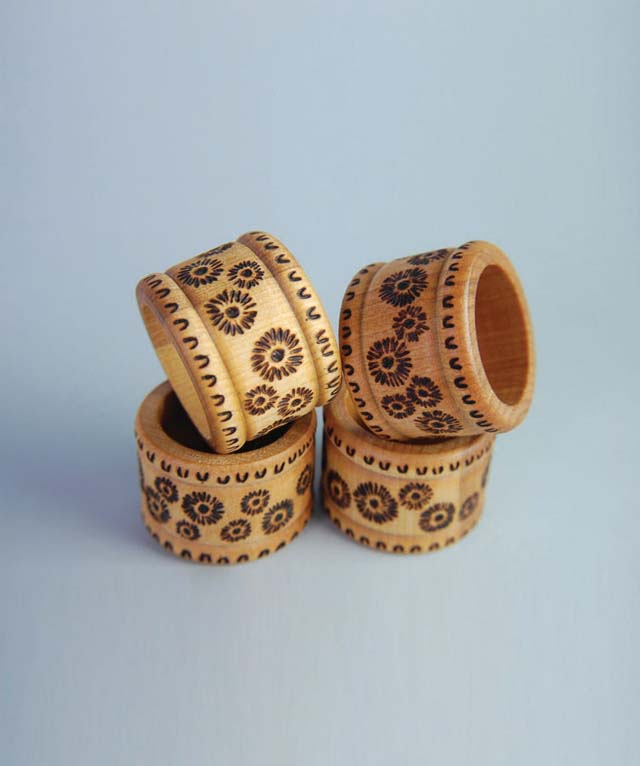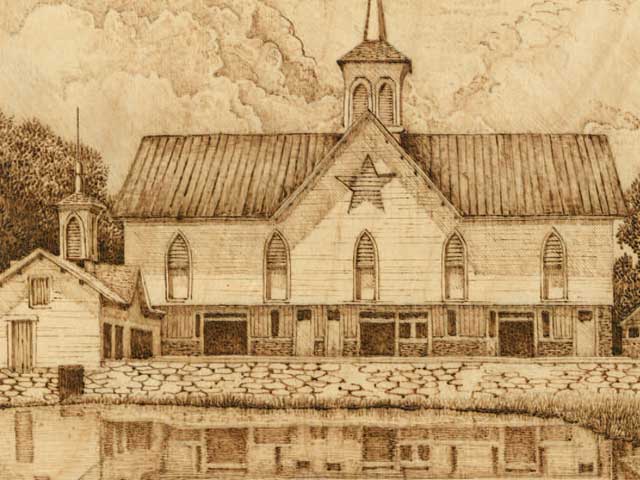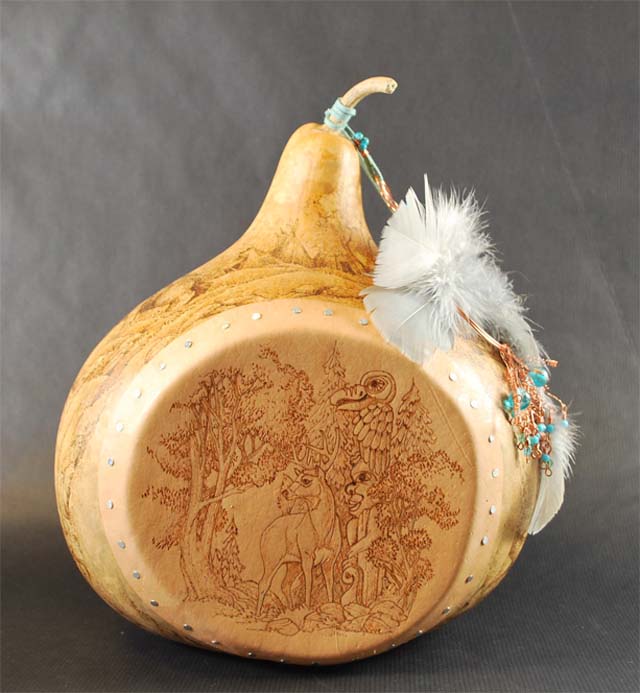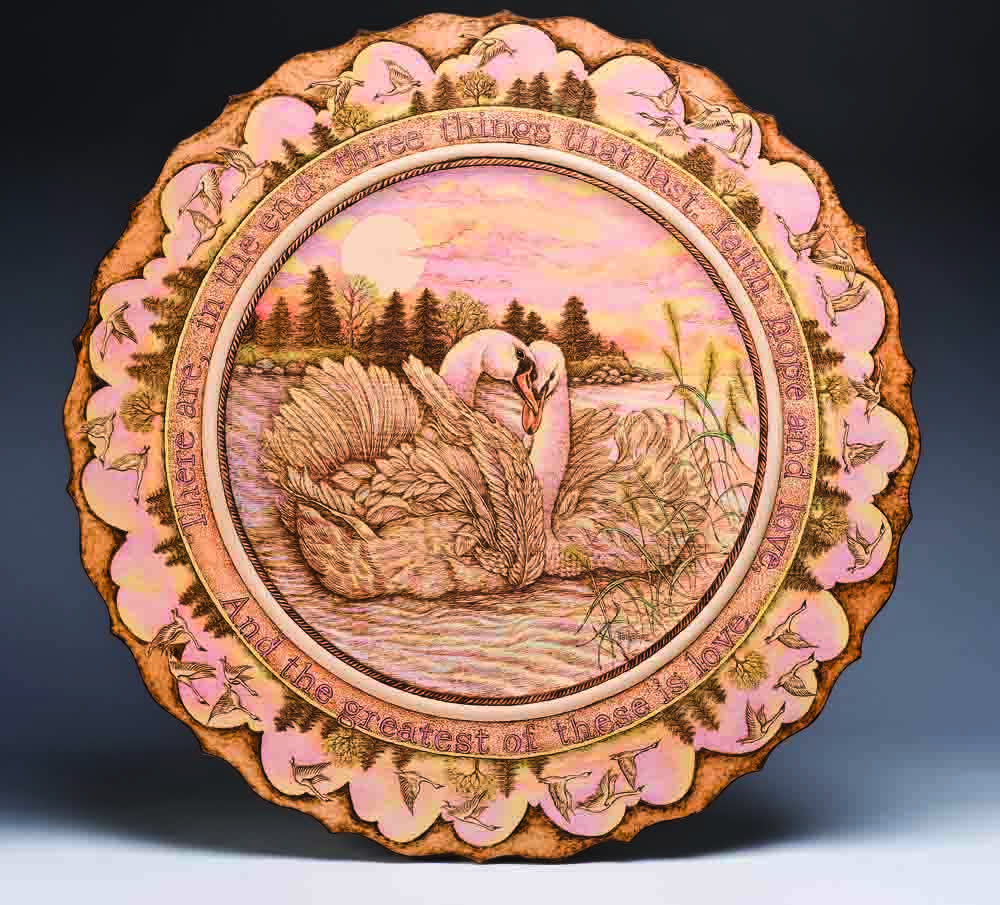Given that Simon Easton calls his pyrographic art “Wood Tattoos,” it seems natural that he cites television tattoo maven Kat von D among his inspirations. It is surprising, however, that this talented artist has been developing his unique style of woodburning for just four years.
Si’s background is in art—he studied woodturning, silversmithing, and pewterware in college and has a degree in three-dimensional design. But he turned to pyrography relatively recently. “I’ve always loved working with wood and fondly remembered using a pyrography machine to decorate a games board I made at school as a child,” said Si. “In 2007, I was looking for a creative outlet again as a means of relaxing from the ‘day job’ and started looking into pyrography equipment. After getting hold of a second-hand kit, I was bitten by the burning bug and quickly moved on to a brand-new machine to cope with the demands of the ideas I wanted to create. Within a year or so, I had a website, was selling at craft fairs and taking commissions, and had been approached by Fox Chapel Publishing to write a book on my style of pyrography.”
Si’s style is eclectic and a departure from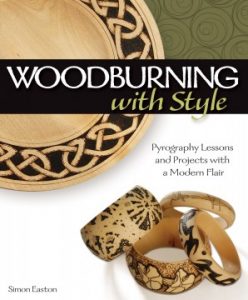 usual woodburning. Instead of tranquil landscapes and wildlife portraits, he burns abstract and tribal patterns, doodles, and line drawings. And rather than creating display pieces, Si often decorates useful objects like bangles, key fobs, picture frames, pendants, boxes, mirrors, and signs. Si said his approach to pyrography developed out of the work he did for his degree. “Whether I’ve been working in wood, metals, or other media, my work has always had a decorative yet tactile quality based on texture and pattern, which I simply continued into my pyrography designs,” he said.
usual woodburning. Instead of tranquil landscapes and wildlife portraits, he burns abstract and tribal patterns, doodles, and line drawings. And rather than creating display pieces, Si often decorates useful objects like bangles, key fobs, picture frames, pendants, boxes, mirrors, and signs. Si said his approach to pyrography developed out of the work he did for his degree. “Whether I’ve been working in wood, metals, or other media, my work has always had a decorative yet tactile quality based on texture and pattern, which I simply continued into my pyrography designs,” he said.
That isn’t to say Si can’t do traditional pyrography. His book for Fox Chapel, “Woodburning with Style,” includes chapters on creating portraits of people and pets, as well as silhouette and realistic landscapes. “I have a varied and open approach to pyrography … I enjoy creating anything and everything, from the traditional realism to more abstract pattern and texture,” he said. “I enjoy creating designs that are meaningful and personal to the customer, and I have yet to tire of that creative buzz I get when I sit down in front of a blank wooden canvas!”
Si is inspired by “anything and everything around me. Tattoo and graffiti art constantly amaze me with the boundaries that they push and expand at such an alarming rate. I have been reading a lot about the tattoos of Kat von D recently and can identify a kinship with the way that she talks about the meaning and personal influences behind a design.” Si has several tattoos and sees a connection between the arts of tattooing and pyrography. As he wrote in the introduction to his book, “The tattoos on my body all mean something to me about a certain stage in my life, and I believe that crafts such as pyrography also have the ability to create something to cherish or remember. I try to recreate that richness and meaning in my pyrography work.” He further noted, “The shape and form of the tribal tattoo are often applied sensitively so they enhance and reflect their position on the human body. … The same technique and deliberation can be applied to the use of such designs on a wooden form or surface.”
Si makes similar connections between pyrography and another of his inspirations, graffiti. He wrote, “There are many parallels in my mind between the use of a spray can and the pyrography machine. Both alter a surface that was clear or pure before the artist started, and a great deal of effort would be required to remove all traces of their work.” Instead of decoration, pyrography designs can “make bold statements and create your own platform of visual expression.” Specifically, Si said, “I admire the irreverent humor of Banksy’s graffitti stencil art .” In a nod to the street artist, Si has experimented with creating pyrography that incorporates graffiti-inspired stencil-like silhouettes.
He wrote, “There are many parallels in my mind between the use of a spray can and the pyrography machine. Both alter a surface that was clear or pure before the artist started, and a great deal of effort would be required to remove all traces of their work.” Instead of decoration, pyrography designs can “make bold statements and create your own platform of visual expression.” Specifically, Si said, “I admire the irreverent humor of Banksy’s graffitti stencil art .” In a nod to the street artist, Si has experimented with creating pyrography that incorporates graffiti-inspired stencil-like silhouettes.
In addition to tattoos and graffitti, Si cites advertising; other forms of art; and local landmarks, legends, and symbols among his inspirations. However, Si’s most constant influence, he said, “has always been surface texture and pattern: I enjoy looking at surfaces through a lens and creating designs based on those natural patterns that we can easily take for granted.”
Si works mainly on wood, especially beech, sycamore, maple, and holly. “I’ve even had some decent results on woods such as pine, which I’ve used for bold, dark designs full of contrast rather than intricacy or delicate shading,” he said. “At the end of the day, it’s all about matching the design and materials successfully.”
Admitting that he’s “never got on well” with solid-point pyrography machines, Si said he uses hot-wire burners by Razertip and Peter Child. “I have several tips that are my ‘old faithfuls’ and get used more often than any others,” he said. “I tend to create most designs using these–a medium skew, small spoon shader, small spear, and a writer. I also shape my own nibs from nichrome wire if I have a particular job in mind that needs a mark which is a little different.”
Si doesn’t often use color, although he occasionally “dabbles” with pencils, ink, or acrylics. He recalls with a laugh an attempt to create a sunset design behind a silhouette landscape. “I think that I rushed it far too much, rather than sensitively paying attention to the subtle nuances of the colors I was trying to recreate, and it ended up a big Technicolor mess. I’ve kept it, and I do think that it actually might make a good Frisbee…”
Lately Si has been busy with commissions, which he said “allow me to tread new ground or require me to go into new territory.” He’s also “in the early stages of some other book ideas … so watch this space.”
he said “allow me to tread new ground or require me to go into new territory.” He’s also “in the early stages of some other book ideas … so watch this space.”
Si encourages fellow pyrographers, especially those just beginning in the art, to explore new possibilities, as well. “I like to see people trying something that challenges them and forces them to go beyond what they thought they could achieve,” he said. “Don’t view anything as ‘wrong’ or a ‘mistake. Be open to the possibility that you may inadvertently solve a problem when you least expect to by creating a particular mark that achieves a result you hadn’t planned for.” Above all, he said, “Enjoy yourself!”
Visit Si Easton online at his website, www.woodtattoos.com; on Facebook, www.facebook.com/woodtattoos; and via Flickr, www.flickr.com/photos/woodtattoos.
You can buy Si’s book, “Woodburning with Style,” from Fox Chapel or your local retailer, or order a signed copy from Si via his website.
- Clients have been keeping Si busy making pet portraits. Si’s fondness for textures easily translates into accurate representations of fur.
- Si created the design on this bowl after closely examining a cross-section of a piece of bone.
- Si has always loved the pattern of leopard fur, so he translated it to a woodburned key fob.
- Using both silhouette and negative silo techniques, Si burned this decoration for a client.
- Si created this landscape scene using textures to imply shapes.

